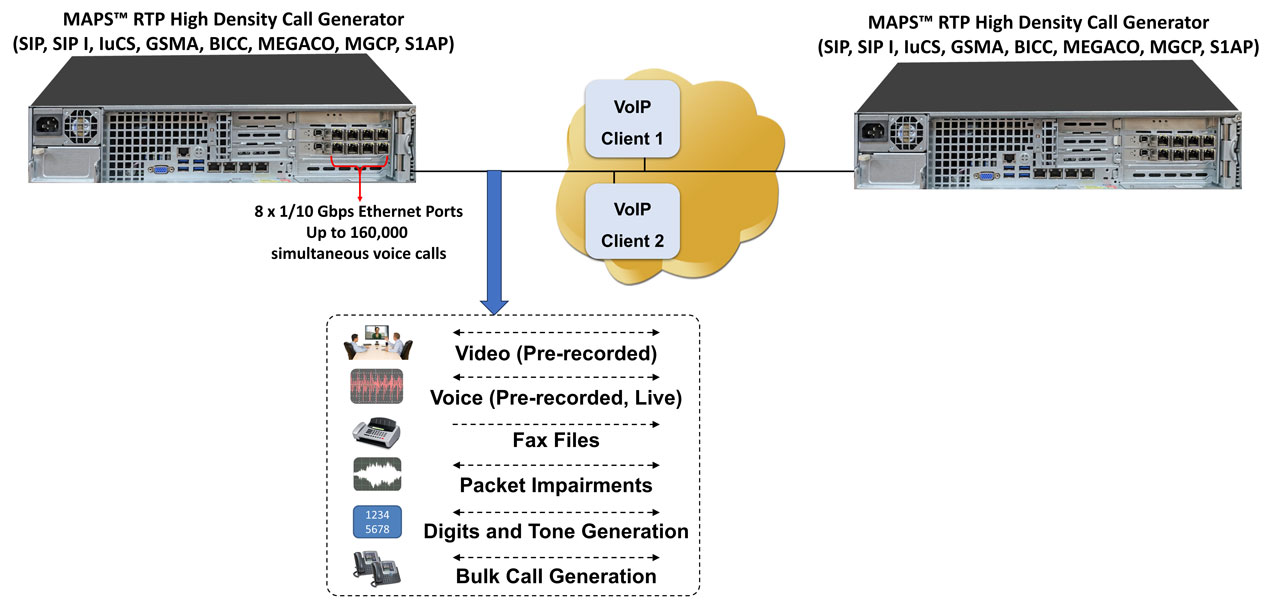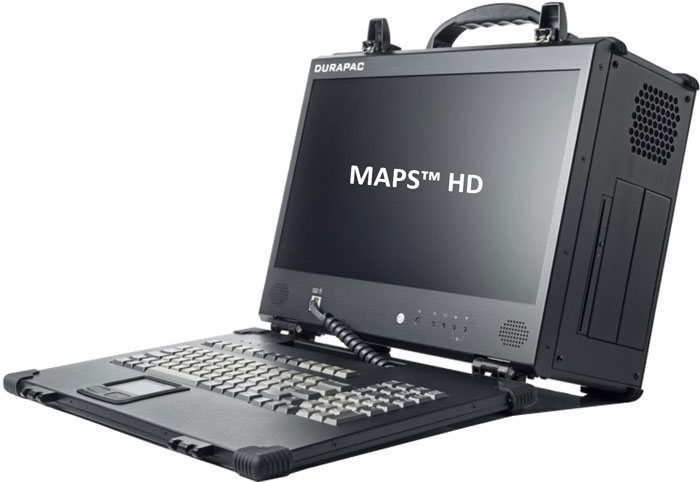GL Enhances High-Density Bulk Call Generator for IP, IMS & LTE Networks
Welcome to another October 2015 issue of GL's Newsletter providing information and insight into our enhanced High-Density Bulk Call Generator for IP and Wireless Networks - referred to as Message Automation and Protocol Simulation High Density (MAPS™ HD).
MAPS™ is GL's standard framework for emulation of IP, TDM, and Wireless protocols (see complete list). The HD version is a special purpose 1U hardware platform capable of high call intensity (hundreds of calls/sec) and high volume of sustained calls (tens of thousands of simultaneous calls/1U platform). Multiple 1U platforms can generate and sustain 100,000 to 200,000 calls all controlled from a single Master Controller.

Overview
Testing IP network performance with high sustained call volume and high call intensity is increasingly important to Wireless Carriers, Internet Service Providers, and Equipment vendors- to ensure that quality of experience does not degrade with call intensity, volume, or protocol. Load and stress testing are important to verify stability of the IP network and network elements during pre and post deployment.
This requires an advanced network appliance which can generate high volume calls with traffic. In addition, packets must be delivered with high precision timing, zero packet loss and in the proper order.

GL's MAPS™ HD is a high density multi-protocol, multi-technology network appliance that performs signaling and traffic generation for a vast array of communication protocols covering IP and Wireless networks. It supports simulation of SIP UA, IMS SIP UE, SIP I+T, SIGTRAN, IuCS, MGCP, NCS, H.248/Megaco, Cisco SCCP (Skinny), GSM-A, BICC, Clear Channel (No Call Control) and provides non-reference-based voice quality using E-model (R-factor) and MOS with five mapping scales.
MAPS™ HD network appliance is designed to easily achieve 4 to 20,000 endpoints per 1U server. Using a stack of multiple servers, a larger test system with 100K-200K calls is achievable for enterprise to carrier grade testing.
The network appliance provides a modular and flexible solution to generate real voice calls using industry standard voice codecs such as G.711 A/µ-law, G.722, G.722.2 (AMR-WB), G.722.1, G.726, G.729A/B, GSM (EFR, FR and HR), AMR (Narrowband and Wideband), EVRC, EVRCB, EVRC-C, iLBC, Speex, SpeexWB, RFC 2833, and user-defined codecs for voice and tones.
MAPS™ HD
GL's MAPS™ HD is a network appliance that generates carrier grade high density calls with traffic for IP and Wireless networks.
- Supports Wide Variety of IP Protocols and Voice Codecs
- 20,000 Calls per 1U Server Chassis
- Scales up to 100k to 200K Simultaneous Calls with Multiple Rack-mounted Server Chassis
- Voice Quality using MOS and E-model (R-factor)
Functional Capabilities
The MAPS™ HD supports high call density, protocol conformance, load generation and stress testing. Through MAPS™ inherent scripting architecture, end-to-end testing of complex networks like Next Generation Voice Networks, Unified Communications, and IMS & Contact Centers is possible.
MAPS™ HD can also measure the performance and capability of an IP network element by simulating various traffic conditions. Load generation can test maximum active call handling capacity, busy hour call attempts, and calls attempted by the simulator at one shot (burst). Stress testing can check for out-of-boundary conditions. Regression tests can be automated and repeatable to ensure that all problems are corrected.
The network appliance can simulate a complete protocol state machine and offers 'syntax-ready commands' to easily build scripts. It provides ready-to-run scripts for simulating important call scenarios or procedures.
The network appliance's syntax-ready commands in script reduce the dependency on technically skilled resources and its re-usability of scripts, messages and profiles reduces 'time-to-market'. Customized test scenarios can be defined to build valid or invalid test cases.
User can modify any signaling messages, message parameters, and/or information elements. User can also add, modify or remove any optional parameter depending on specific feature of interest. Packet level fault insertion can be performed by impairing any bit / byte of a message.
Important Features
MAPS™ HD supports the following:
- Transport over UDP and TCP, IPv4 and IPv6, and TLS for secure transport
- Unique endpoint emulation using IP address, MAC address, and VLAN tagging
- From 4 to 20,000 endpoints in a single server
- Up to 250 Calls Per Second
- Scales to around 100,000 endpoints with use of Master Controller for single point of control
- Manage 10+ MAPS™ systems with single point of control from Master Controller
- Powerful Load Generation, Scheduler, and Command Line Interface (CLI) for automation, remote control, and load testing
- Configurations, test scripts, and profiles can be saved and reused on a different systems
- Easy-to-use MAPS™ Scripting interface (UI) for test scripts to be created
- Real-time monitoring and reporting of registration and call statistics
- Statistics can be viewed on any pair of endpoints
- Export data to other applications for customized user report
- QOS (C-MOS,L-MOS,PacketLoss etc) calculation on received traffic
- Generation and detection of Digits/Tones for 1000 simultaneous calls
- Talk and play to speaker options using PC sound card
- Send and Record file for all supported codecs
Applications
MAPS™ HD has many applications including:
- Pre and post deployment testing of enterprise, ISP, and Carrier Networks
- Quality of Experience (QoE) evaluation as a function of signaling or traffic load or protocol variation
- Networks Applications for
- IP, Mobile Broadband, SIP, IMS, Wireless
- Quality of Service (QoS) for voice
- Contact Center and Unified Communications
- Interactive Voice Response System (IVR), Automatic Call Distributor (ACD), routing, Computer Telephony Integration (CTI), CRM, chat, presence, conferencing, speech, and agent desktop applications
- Security
- Denial of Service, Theft of Service, traffic floods, intrusion prevention, firewalls, intrusion detection systems, and security gateways
- Network elements
- Session border controllers, network border elements, application level gateways and deep packet inspection devices, and intrusion prevention/intrusion detection systems
 Back to Newsletter Index Page
Back to Newsletter Index Page